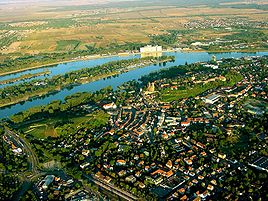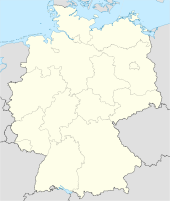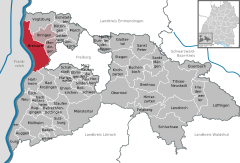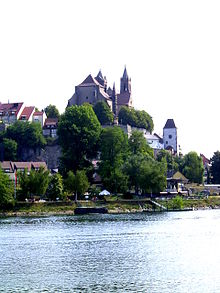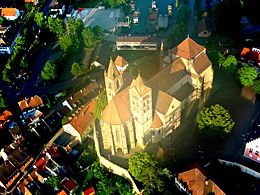- Breisach
-
Breisach 
Coordinates 48°1′44″N 7°34′48″E / 48.02889°N 7.58°ECoordinates: 48°1′44″N 7°34′48″E / 48.02889°N 7.58°E Administration Country Germany State Baden-Württemberg Admin. region Freiburg District Breisgau-Hochschwarzwald Town subdivisions 12 Mayor Oliver Rein Basic statistics Area 54.58 km2 (21.07 sq mi) Elevation 225 m (738 ft) Population 14,505 (31 December 2010)[1] - Density 266 /km2 (688 /sq mi) Other information Time zone CET/CEST (UTC+1/+2) Licence plate FR Postal codes 79200–79206 Area code 07667 Website www.breisach.de Breisach (formerly Altbreisach) is a town with approximately 16,500 inhabitants, situated along the Rhine in the Rhine Valley, in the district Breisgau-Hochschwarzwald, Baden-Württemberg, Germany, about halfway between Freiburg and Colmar — 20 kilometres away from each — and about 60 kilometres north of Basel near the Kaiserstuhl. A bridge leads over the Rhine to Neuf-Brisach, Alsace.
Its name is Celtic and means breakwater. The root Breis can also be found in the French word briser meaning to break. The hill, on which Breisach came into existence was — at least when there was a flood — in the middle of the Rhine until the Rhine was straightened by the engineer Johann Gottfried Tulla in the 19th century, thus breaking its surge.
Contents
History
The seat of a Celtic prince was at the hill on which Breisach is built. The Romans maintained an auxiliary castle on Mons Brisiacus (which came from the celtic word Brisger which means waterbreak) The Staufer founded Breisach as a city in today's sense. But there had already been a settlement with a church at the time. An 11th century coin from Breisach was found in the Sandur hoard.
In the early 13th century, construction on the St. Stephansmünster, the cathedral in Breisach, started. In the early 16th century, Breisach was a significant stronghold of the Holy Roman Empire. On December 7, 1638, Bernhard of Saxe-Weimar, who was subsidized by France, conquered the city, which Ferdinand II and General Reinach had defended well, and tried to make the centre of a new territory. After Bernhard's death in 1639, his general gave the territory to France, which saw it as its own conquest. In the Peace of Westphalia in 1648, Breisach was de jure given to France.
From 1670, Breisach was integrated into the French state in the course of the politics of Reunions. In the Treaty of Ryswick in 1697, Breisach was returned to the Holy Roman Empire, but then reconquered on September 7, 1703 by General Villars at the beginning of the War of the Spanish Succession. At the Treaty of Rastatt on March 7, 1714, Breisach became once again part of the Empire. Meanwhile, France founded its own fortress, Neuf-Brisach ("New Breisach"), on the left shore of the Rhine. In 1790, Breisach was part of Further Austria. In the revolutionary wars in 1793, Breisach sustained heavy damage and then, in 1805, was annexed to the de facto re-established state of Baden.
During World War II, 85% of Breisach was destroyed by Allied artillery as the Allies crossed the Rhine. The St. Stephansmünster was also heavily damaged.
In 1969, Breisach was considered as the construction site for a nuclear power plant, but Wyhl was chosen instead, where the construction project was later abandoned in the face of heavy opposition.
The near-by cities of Hochstetten (1970), Gündlingen (1972), Niederrimsingen (1973), and Oberrimsingen (1975) along with Grezhausen, which had been incorporated into Oberrimsingen in 1936, were all incorporated into Breisach.
Politics
After the municipal elections on June 13, 2004, the seats in the municipal council were distributed as follows:
CDU 43,9 % −3,9 12 Seats ±0 SPD 24,3 % −2,1 6 Seats ±0 Unaffiliated 16,8 % +3,9 4 Seats +1 FDP/DVP 15,0 % +2,1 4 Seats +1 Economy and infrastructure
Transportation
Breisach was, until 1945, the frontier station on the Freiburg–Colmar international railway line. Since the railway bridge across the Rhine was destroyed during the Second World War, railway services have been restricted to the German side of the river. The Breisgau S-Bahn connects Breisach to Freiburg via Gottenheim over the remaining section of the Freiburg–Colmar line, whilst the Kaiserstuhlbahn connects Breisach to Riegel via Vogtsburg and Endingen.
The federal road B 31 leads to Lindau and the N 415 on the French side connects Breisach to Colmar.
Local businesses
One of Europe's largest wine cellars called Badische Winzerkeller eG is located in Breisach. Viticulture is very important for the economy of both Breisach and the Kaisertuhl.
Main sights
The museum for municipal history has an impressive collection dating from the Stone Age to the present. The Romanesque St. Stephansmünster, the cathedral in Breisach, has a late Gothic altar by an unknown craftsman (with the initials H.L.) and paintings by Martin Schongauer, who is also the eponym of the Gymnasium in the city.
International relations
Breisach is twinned with: Breisach is partnered with the following cities:
 Saint-Louis, France, since 1960
Saint-Louis, France, since 1960 Pürgg-Trautenfels, Austria, since 1994 partnered with the borough of Niederrimsingen
Pürgg-Trautenfels, Austria, since 1994 partnered with the borough of Niederrimsingen Neuf-Brisach, France, since 2000
Neuf-Brisach, France, since 2000
References
- ^ "Bevölkerung und Erwerbstätigkeit" (in German). Statistisches Landesamt Baden-Württemberg. 31 December 2009. http://www.statistik-bw.de/Veroeffentl/Statistische_Berichte/3126_10001.pdf.
- This article incorporates information from the revision as of July 12, 2006 of the equivalent article on the German Wikipedia.
External links
- Official website in English
- Breisach – pictures & history (German)
Au | Auggen | Badenweiler | Bad Krozingen | Ballrechten-Dottingen | Bötzingen | Bollschweil | Breisach | Breitnau | Buchenbach | Buggingen | Ebringen | Ehrenkirchen | Eichstetten am Kaiserstuhl | Eisenbach | Eschbach | Feldberg | Friedenweiler | Glottertal | Gottenheim | Gundelfingen | Hartheim | Heitersheim | Heuweiler | Hinterzarten | Horben | Ihringen | Kirchzarten | Lenzkirch | Löffingen | March | Merdingen | Merzhausen | Müllheim | Münstertal | Neuenburg am Rhein | Oberried | Pfaffenweiler | Schallstadt | Schluchsee | Sölden | Sankt Märgen | Sankt Peter | Staufen | Stegen | Sulzburg | Titisee-Neustadt | Umkirch | Vogtsburg | WittnauCategories:- Towns in Baden-Württemberg
- Breisgau-Hochschwarzwald
- Sequani
- Populated places on the Rhine
Wikimedia Foundation. 2010.

